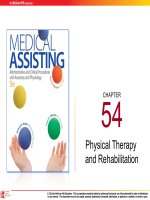177 medical assisting administrative and clinical procedures (5e) chapter 24 the skeletal system
Bạn đang xem bản rút gọn của tài liệu. Xem và tải ngay bản đầy đủ của tài liệu tại đây (1.47 MB, 58 trang )
CHAPTER
24
The Skeletal
System
24-2
Learning Outcomes (cont.)
24.1 Describe the structure of bone tissue.
24.2 Explain the functions of bones.
24.3 Compare intramembranous and
endochondral ossification.
24.4 Describe the skeletal structures and one
location of each structure.
24-3
Learning Outcomes (cont.)
24.5 Locate the bones of the skull.
24.6 Locate the bones of the spinal column.
24.7 Locate the bones of the rib cage.
24.8 Locate the bones of the shoulders, arms,
and hands.
24-4
Learning Outcomes (cont.)
24.9 Locate the bones of the hips, legs, and feet.
24.10 Describe the three major types of joints and
give examples of each.
24.11 Describe the common diseases and
disorders of the skeletal system.
24-5
Introduction
• Bones provide
structure and
support
• 206 bones plus
joints and
connective tissue
•
Divisions
– Axial ~ 80 bones
• Skull
• Vertebral column
• Rib cage
– Appendicular ~ 126
bones
• Arms and legs
• Pectoral girdle
• Pelvic girdle
24-6
Bone Structure
•
Bones contain various kinds of tissues
–
–
–
•
Osseous tissue
Blood vessels
Nerves
Osseous tissue can
appear compact or
spongy
Spongy
(Cancellous)
Bone
Compact
Bone
24-7
Bone Structure (cont.)
•
Structures within compact bone
–
–
–
–
–
•
Osteons
Bone matrix
Lamella
Lacunae
Canaliculi
All bones are made up of both compact and
spongy bone
24-8
Bone Structure (cont.)
• Long bones
– Femur and humerus
– Parts
• Diaphysis
• Epiphysis
• Articular cartilage
• Medullary cavity
• Periosteum
• Endosteum
24-9
Bone Structure (cont.)
• Short bones
• Flat bones
• Irregular bones
• Sesamoid bones
24-10
Gender Differences in Skeletal Structure
• Male Skull
– Larger and heavier
• Male pelvis
– Bones are heavier and
thicker
– Forehead shorter
– Cavity is narrower
– Face less round
– Jaw larger
24-11
Apply Your Knowledge
Matching:
ANSWER:
C Holes in the matrix that contain
osteocytes
B Made of inorganic salts, collagen
fibers, and proteins; between
osteocytes
D Layers of bone surrounding the canals
of the osteons
A Elongated cylinders that run the length
of the bone
E Canals that connect lacunae
to each other
A. Osteons
B. Bone matrix
C. Lamella
D. Lacunae
E. Caniculi
Very
Good!
24-12
Functions of Bones
•
Give shape to body parts
•
Support and protect soft
structures
•
Function in body movement
• Red bone marrow – hematopoiesis
• Store calcium
24-13
Apply Your Knowledge
Why is it important for the bones to store calcium?
ANSWER: Every cell in the body needs calcium, so the
body must have a large supply readily available.
24-14
Bone Growth
• Ossification
• Intramembranous ossification
– Bones begin as tough, fibrous membrane
– Osteoblasts turn the
membrane to bone
24-15
Bone Growth (cont.)
•
Endochondral ossification
–
Bones begin as cartilage models
–
Diaphysis ~ primary ossification center
Diaphysis
24-16
Bone Growth (cont.)
•
Endochondral ossification
–
Epiphysis ~ secondary ossification center
–
Epiphyseal disc ~ cartilage between epiphysis
and diaphysis
Diaphysis
24-17
Building Better Bones
•
•
Bone – healthy diet
–
Vitamin D
–
Calcium
Bone-healthy exercises
–
Weight-bearing
–
Strength-training
24-18
Building Better Bones (cont.)
• Bone-healthy lifestyle – avoid smoking
and alcohol
• Bone tests
– Bone density tests
– Bone scan
24-19
Apply Your Knowledge
What are the two types of bone growth?
ANSWER: Intramembranous ossification, in which
bones begin as tough membrane and are turned to
bone by osteoblasts, and endochondral ossification, in
which primary ossification occurs in the diaphysis of
the bone and secondary ossification occurs in the
epiphysis.
Good Job!
24-20
Bony Structures
•
Bones are designed with
–
Projections and processes
–
Depressions and hollows at
articulations
–
Openings for blood vessels
and nerves
24-21
Bony Structures (cont.)
Term
Condyle
Definition
A rounded process that usually
articulates with another bone
Crest
A narrow, ridge-like projection
Epicondyle
A projection situated above a condyle
Foramen
An opening through a bone that is
usually a passageway for blood
vessels, nerves, or ligaments
Fossa
A relatively deep pit or depression
24-22
Bony Structures (cont.)
Term
Head
Process
Suture
Definition
An enlargement on the end of a bone
A prominent projection on a bone
An interlocking line of union between
bones
Trochanter
A relatively large process
Tubercle
A small, knoblike process
Tuberosity
A knoblike process, usually larger than
a tubercle
24-23
Apply Your Knowledge
Match the following:
ANSWER:
E Epicondyle A. A relatively deep pit or depression
___
C Fontanels B. An interlocking line of union between bones
___
A Fossa
___
C. “Soft spots” felt on an infant’s skull
F Process
___
D. A knoblike process, usually larger than a
tubercle
B Suture
___
E. A projection situated above a condyle
D Tuberosity F. A prominent projection on a bone
___
24-24
The Skull
•
Two bone types – cranial and facial
•
Infant skulls
–
Bones not completely formed
–
Fontanels – tough membranes
–
Sutures
24-25
The Skull (cont.)
•
Cranial bones
–
Frontal
–
Parietal
– External auditory
meatus
–
Occipital
– Sphenoid and
ethmoid bones
–
Temporal
– Ear ossicles
Click to see
Skull
• Malleus
• Incus
• Stapes









